Winter Trail Running – A Buyers Guide
Posted by Chris Futers on Dec 14, 2022

It's turning dark, the winds blowing and the temperature is certainly dropping, also it's wet! Welcome to winter in the UK. Fear not, we don’t have to hang our running shoes up until spring, the trails are still out there, even if they are hidden by a layer of snow.
The same basic kit list will see us through most of the year; t-shirt, shorts, socks and trainers. Winter conditions cause us to re-think this, looking at clothing and equipment that will help us better enjoy and achieve our goals on the winter trail. At Ultralight Outdoor Gear, we have what’s needed to continue trail running through the winter months and here is your one stop check list from head to toe;
First of all, whether you’re starting from your front door heading out to your local park trail after work or setting off into the mountains on an ultra, I always abide by the following motto; ‘be bold, start off cold’. This doesn’t mean wearing skimpy shorts and a string vest, however, don’t go putting all your layer’s on from the off; stash them away in your running pack/waist pack. No pack, no worries. You can still be bold and start off cold, just consider your options before heading out the door, i.e., are gloves needed? Can I go for a headband over a full hat? Would a long sleeve tee be sufficient rather than an additional thermal layer? If it’s raining…. I’ll leave that one up to you.
Top Picks; Gecko WP+ Waist Pack, UltraFire 5 Vest Pack with 2x 350ml Flexi Flasks and the Race Ultra Pro 2in1 Vest Pack.
Headwear
We’ve established its cold, and with ‘that wind’ mixed in, your ears will be numb! Therefore, something to cover the flaps on the side of our heads is a must if you ask me. Let’s not go overkill and go for a super thick fleece lined beanie. Whilst we want some degree of warmth, as runners, we need to think about breathability and fit. Stretch fabric that conforms to our heads is ideal for runners as the last thing we want is our hat falling off or obstructing our vision. Therefore, a secure fit is key. I personally prefer a head band to allow better body/head temperature regulation although a close-fitting hat with moisture wicking capabilities would be worth considering.
My headwear Top Picks; The Inov8 Train Elite Beanie offers great moisture wicking ability whilst providing a decent amount of warmth. The stretch fit means it conforms well to fit the head staying in place throughout your run.
Montane’s Via Stretch Headband is extremely lightweight and breathable making it an easy addition on your run that can be stored away with ease. The ergonomic design provides a good fit covering the ears from the dreaded wind chill. Having used this on nearly all outings I find it a versatile option, not only for runs on the trail, but under a bike helmet or when exposed on hikes.
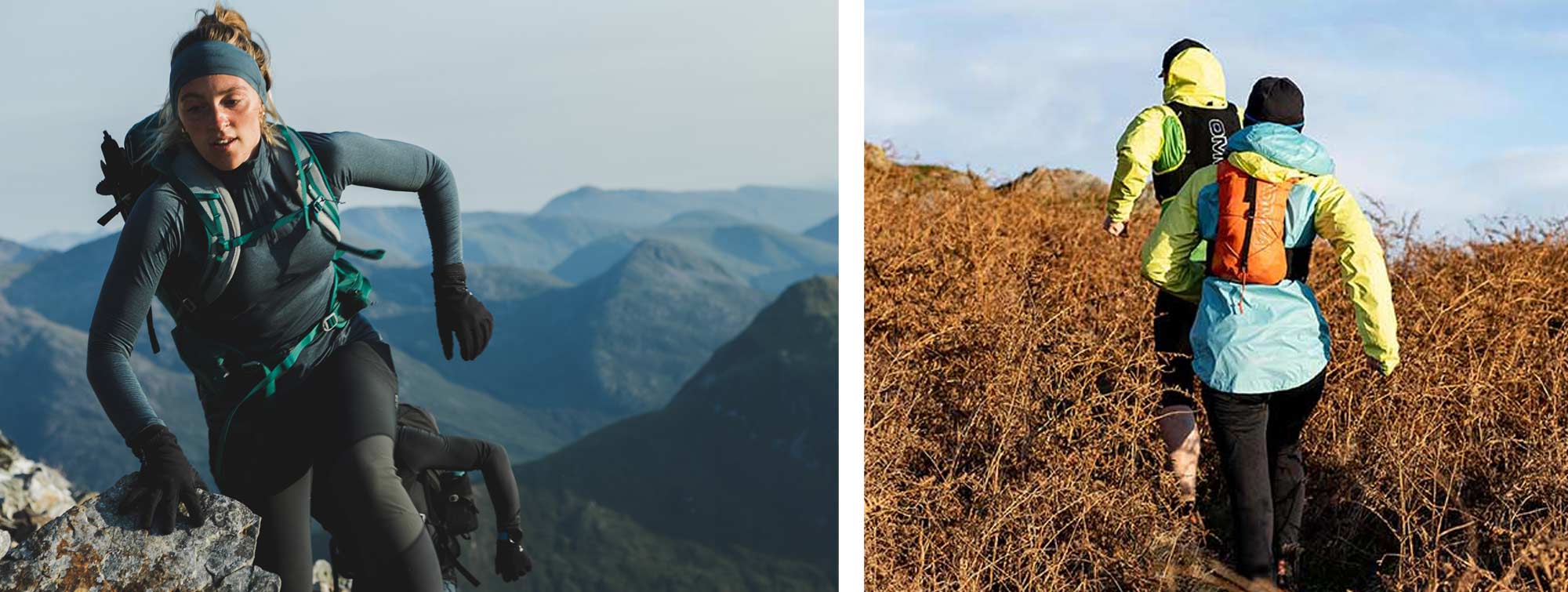
Head Torch
It’s dark! Yes, winter time does mean less day light and therefore I’d highly recommend taking a head torch to light the way on the undulating and unpredictable terrain. Even if you plan to be out and back in day light hours, in the case of an emergency or unforeseen events a head torch is a must if not only for safety. So, what makes a good running head torch? For one, we’re moving around and taking more impact throughout our bodies than the average hiker, thus we need our head torch to be able to stay in a fixed position even more so. Look out for torches where the headband has additional features such as silicon strips that help provide a more secure fit/grip. Another important feature for trail runners is the type of light we need. Each step we take is less predictable than when road running and we’re constantly scanning the ground, looking for the best foot placements, each time taking micro-seconds to do so. Having a head torch that spreads light close to us at a wider arc, will help us achieve better peripheral vision and therefore overcome any obstacles. Lumens - whilst a lower lumen option would suffice on the road we need to take in more information, scanning further ahead on the trail and generally will find ourselves running in more remote locations and therefore away from any light pollution. I would suggest a minimum of 300 ‘max Lumen’ for the trail.
Head Torch Top Picks; A recent addition to UOG has been Silva’s headtorches, which include trail running specific range. Whilst ticking all the boxes mentioned above, each torch features Silva Intelligent Light® which is a unique combination of a long reach spotlight and a close flood light and the light output in the Trail Runner is optimized for running. This customization of the light results in less head movement and a clear view of near as well as far obstacles, and you gain the balance and confidence it takes to move fast and perform better. The batteries can be carried comfortably on the headband or be kept warm in your pocket to save battery life by using the included extension cord making them a perfect option for winter trail running.

Upper Body
High wicking materials are essential for running; however, fabrics need to be resilient enough on the trail, especially when wearing packs. I would avoid pure wool tees (such as merino) as the longevity/ durability when running with packs may be comprised somewhat although a fabric blend of merino and synthetic which offers some warmth, highly breathable fabric and durability is available. I for one would opt more towards polyester which can be manipulated to produce all the features desired whilst still being long lasting. Whether you go for a long sleeve or short depends on your layering system;
My Baselayer Top Pick’s; Rab’s Force SS Tee offers a quick wicking fabric with an active fit so it is comfortable next to the skin to move ergonomically when running. The added bonus of this Tee is dropped shoulder seams for comfort with a pack;
The Base Elite long sleeve Tee from Inov8 is constructed with durable recycled polyester yarns. The Inov8 Base Elite is a featherlight and fast-drying long-sleeve running base-layer that quickly wicks any moisture away from the body. Highly breathable and supremely odour resistant, this base-layer is perfect for long runs or intense sweaty sessions. Requires less laundering and will be the base-layer you reach for time and time again. The welded hem and cuffs ensure maximum comfort and zero irritation in those areas.
OMM's Flow Tee Zip L/S provides more versatility with the long sleeves offering full coverage and more warmth for those colder days out while the deep zip allows you to vent and dump heat more effectively. Ideally suited to events like the OMM and other races in challenging conditions.
Sleeves
The automatic assumption with cold weather running is to go for the long sleeve option, whilst valid, trial and tested, there is a more versatile way to go… I for one alternate temperatures throughout my run, feeling the cold more at times. Teaming up your short sleeve base layer with arm sleeves can provide a versatile solution.
Easy storable and simply slipped on when required Montane’s Trail Armguards and are a practical option. Carry these along with you on the trail, they add extra protection for little weight penalty. They are comfortable to wear and offer an alternative to carrying extra layers of clothing.
Warm Layer
If the temperature is dropping or you’re stopping, adding an additional layer will help keep you warm and a smile on your face. Well, I can’t promise you’ll be smiling… Aside from the thermal properties we want from this layer, moisture management is a key feature we’re looking for when making our choice, the last thing we want to do is have moisture trapped between our base layer and shell. OMM’s ‘Core’ range is designed as an active insulation made entirely from PRIMALOFT ACTIVE and is woven through a knitted mesh to be fully air permeable. OMM say ‘’This allows you to keep your Core layer on even when you have warmed up and you can thermoregulate by removing/unzipping your low bulk shell’’. For me a definite top pick for winter trail running and available not only as an upper layer but as leg wear.
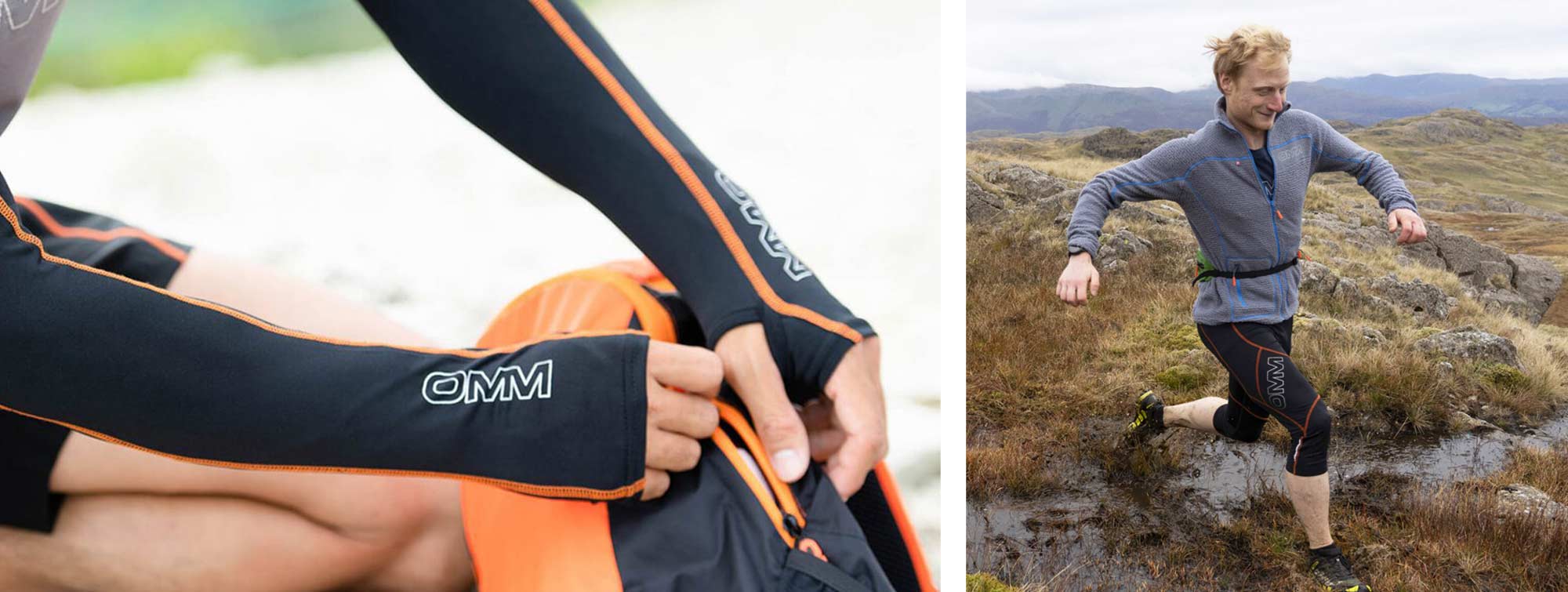
Waterproof
Our normal water resistant/showerproof jacket simply will not ‘cut it’ in the harsher winter conditions, we need something that will actually keep out the rain. A minimum of 20,000 HH I would recommend in the UK outside of spring/summer conditions. Superlight weight and breathability do not have to be compromised with options that still hit our minimum waterproof recommendation that all have a high Moisture Vapour Transition Rates (MVTR) as displayed in the below top picks.
Waterproof Top Picks; Hyper 100 Shell Jacket and the Raceshell Pro Z
So, our jackets are going to be more exposed to the elements, will face more friction with a pack on our back and have to deal with rubbing up against the odd rockface whilst navigating the trail. It therefore, pays to have a shell that is robust enough to take this sort of use as well as standing up against the harshest weather you’re willing to go out running in, this is where you need to start looking at 3-layer construction for maximum durability (1 - moisture wicking backing, 2 - waterproof membrane and 3 - outer shell) and a higher denier level. With this in mind, the following are also part of my top pick options; Phase lite Gore-Tex Jacket and Kamleika Jacket.
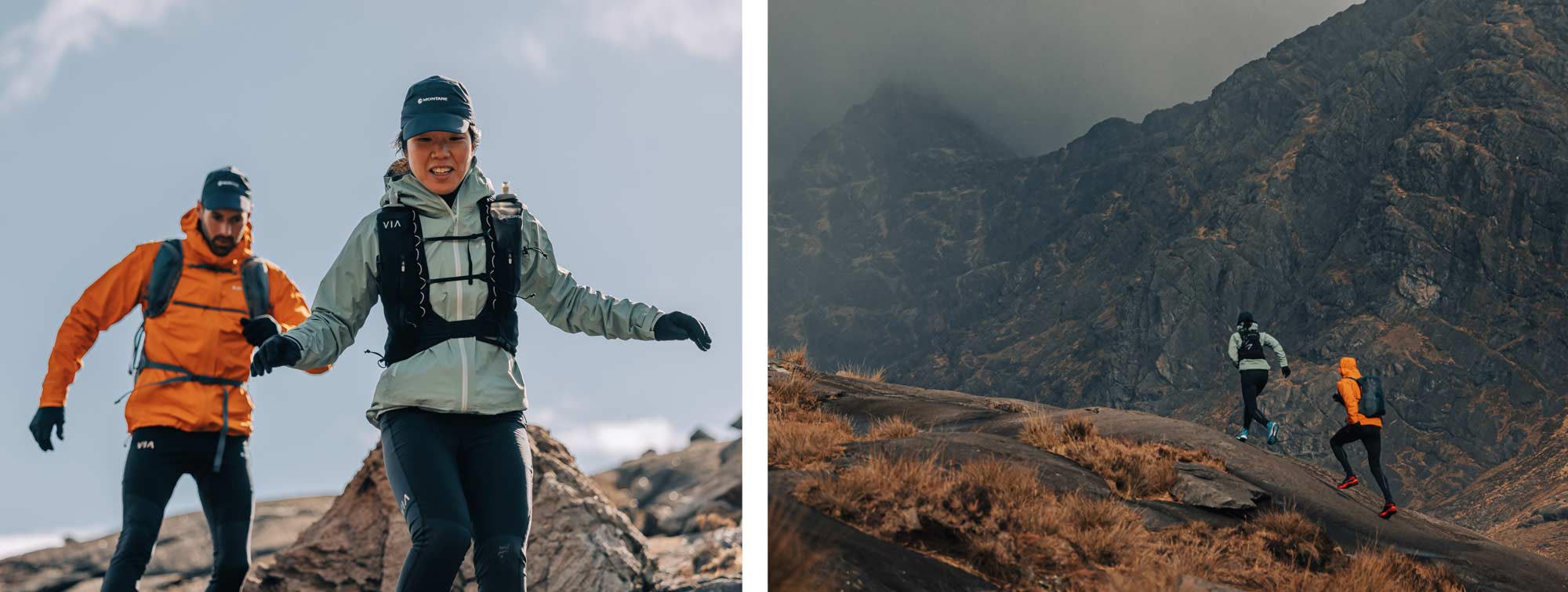
Gloves
Always a part of mandatory kit for fell/trail races, gloves become part of my kit list from mid-autumn as the air temperature drops and whilst an often-overlooked item, the multitude of features that can be offered from one glove to another can differ. Looking to make our kit list specific for the trails, we have to ask ourselves ‘’what makes ‘these’ gloves different from other running gloves’’. For one we will use our hands more to push of/ scramble up rock, so we require the palms to be more durable and grippy, thus look out for ‘grip’ patterns and/or more durable materials (not wool palmed). Having a mobile device is a good idea when heading into the fells in case of emergencies thus touch screen capability is worth considering.
I’m sure we’re all aware that once it gets cold out on the run our nose starts to leek! So, we’re left with the choice, to ‘snot rocket’ or to wipe? Well, if you’re a wiper we have gloves that are provided with nose-wipe thumb feature, hooray! Snot rocketeers... you just do your thing.
I’d personally avoid a fully waterproof glove for running just to help maximise the breathability of the glove, however a waterproof over-mitt can solve this issue which are easily popped in a pocket of your pack.
Glove Top Picks; Race Elite Gloves, Helium Wind Convertible Liners, Maze Runner Gloves and Fusion Gloves.
Legs
Do you want your knees on show in the winter? If you’re a seasoned trail runner and shorts are still the way forward for you in winter, we have a vast array of trail running specific options available for you to choose from. I would still consider something that provides a little more warmth, thus adding a few more inches and consider a 2-layer system, this not only adds a bit of warmth but are super comfortable and helps prevent chaffing. Personally, I opt for tights, especially in the depths of winter. No tights are alike in terms of length, thickness, features etc. So, depending on the temperature forecast you have to decide between ¾ tights or full, along with the respective thermal properties. What remains a constant across all our running clothing is the moisture wicking capabilities.
Legwear Top Picks; Inov8’s TrailFly Ultra 7’’ 2in1 Shorts are packed with features for the trail, chafe-free design, DWR treated, the wide elasticated hem helps maintain a good fit through long runs and the large rear pocket is ample enough for smart phones along with some nutrition. These loaded features help set them apart from the rest.
Flash Tights 1.0 from OMM tick all the boxes for me for cold weather running, providing the perfect mix between thickness, weight and thermal properties. The four-way stretch allows for a good fit and works ergonomically with the runner making them very comfortable to wear. The added features also help make this a top pick, for example, the strategically placed mesh panels really do help regulate body temperature and the stretch pockets at the thigh are generous to carry items you want quick to hand such as hats and gloves.
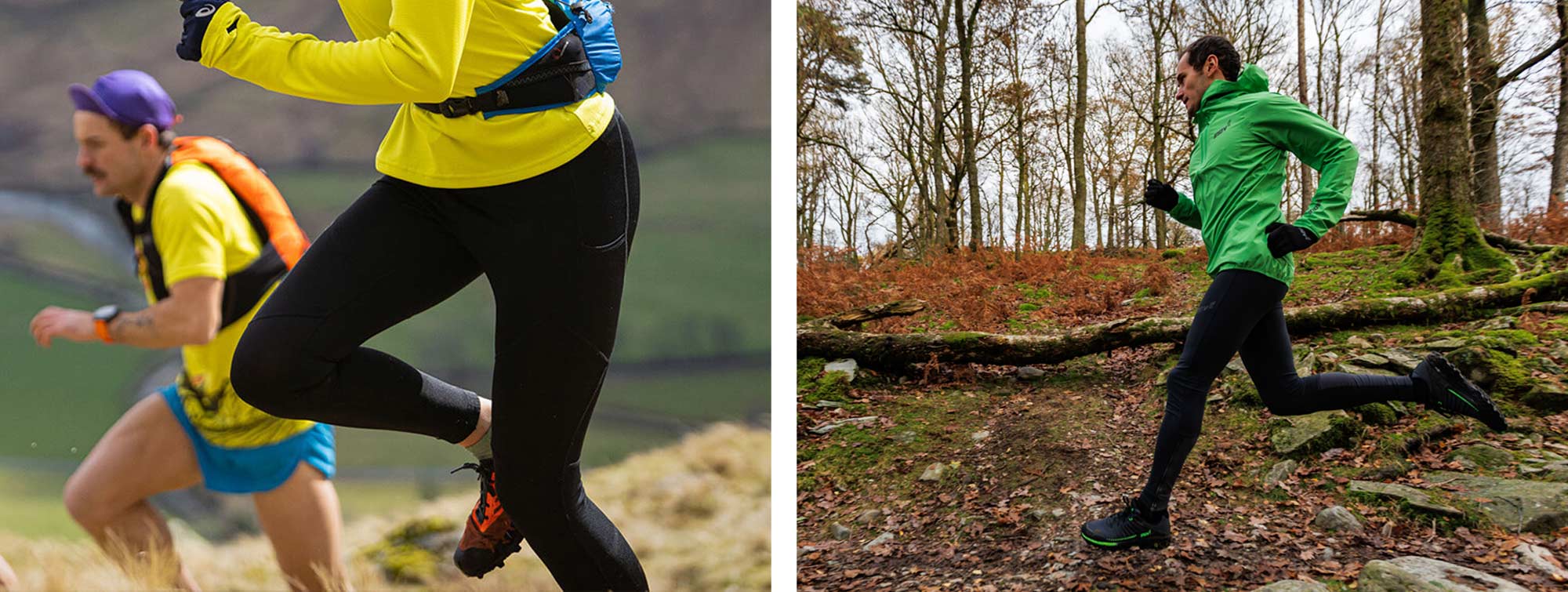
Feet
Trail Shoes
There are 1000’s of blogs and reviews on this subject that will sing the praises of one shoe over another. However, with such a personal choice which depends greatly on the fit and therefore the ‘Last’ shape of each model it is best placed to let you choose. With that said it is worth making note of key features to look out for when picking a shoe specifically for the winter tail. For rest of the year I wouldn't really consider a waterproof trail shoe, but with the introduction of frost and snow, your footwear can soon get saturated with ice cold water soaking onto your feet… not nice. Teaming a waterproof shoe up with trail gaiters (or built-in gaiter) can prove a sure-fire way to avoid your feet turning to a block of ice! Another consideration is tread pattern and depth, more spacing between each ‘lug’ will help prevent the tread from clogging up and therefore helps maintain traction in muddy and/or snowy conditions. The depth of the ‘lugs’ is fully dependent on the conditions. Muddy and snow-covered fells call for a deeper ‘lug’, this is not as essential on more well maintained trails. My top picks this winter are;
Top Picks; Lone Peak All-WTHR Low, Uragano GTX, Golden Gate ATR, All Terrain Gaiter and Ferrosi Hybrid Gaiters.
Socks
Yet another often overlooked item of our running kit, however with careful consideration the right pair of socks can make the difference to our performance and levels of enjoyment on the trail. One game changer could be the option to ‘run’ waterproof socks. Most of the time it is more of a matter of time, not if, that water is going to breach your shoes, so why not supplement your kit list with Seal Skins Waterproof Warm Weather Ankle Length Sock with Hydrostop socks? No reason to at least give it a whirl I say, teaming these up with your non-waterproof trail shoe might just be the answer you’ve been looking for that you may not have considered.
Other Considerations
Neckwear
A great versatile addition for colder conditions that can be used as prescribed for the neck, or manipulated to a headband or beanie. Just consider how much additional warmth you want to gain from this item and depending on your answer look towards heavier weight fleece options for greater thermal properties. Don’t worry at a max weight of 81g you won’t notice this additional load.
Top Picks; Thermal Snood, 2022 Filament Neck Tube and DryFlx Tubular.
Emergency kit
Compass, first aid, emergency bivy, whistle, warm glove/mitts.
Don’t lose respect for the great outdoors, whilst you never plan to use your emergency kit, always plan for the worst. It might just save your own or someone’s life!
Top Picks; Ark Emergency Bivi, Twilight Bivi, Ultralight & Watertight .3 Medical Kit and Field Compass.
Crampons/Spikes
Crampons come in various styles from the occasional streetwear used through to ice climbing up the side of a mountain gully. What we require is a non-ridge flexible crampon that is relatively simple to slip on and off, as for the most part of our trail the likelihood of needing a crampon will be low. However, when things get dicey this additional item could be a godsend when heading out in snowy, icy conditions.
Top Picks; Trail Micro Crampons and EXOspikes Footwear Traction.
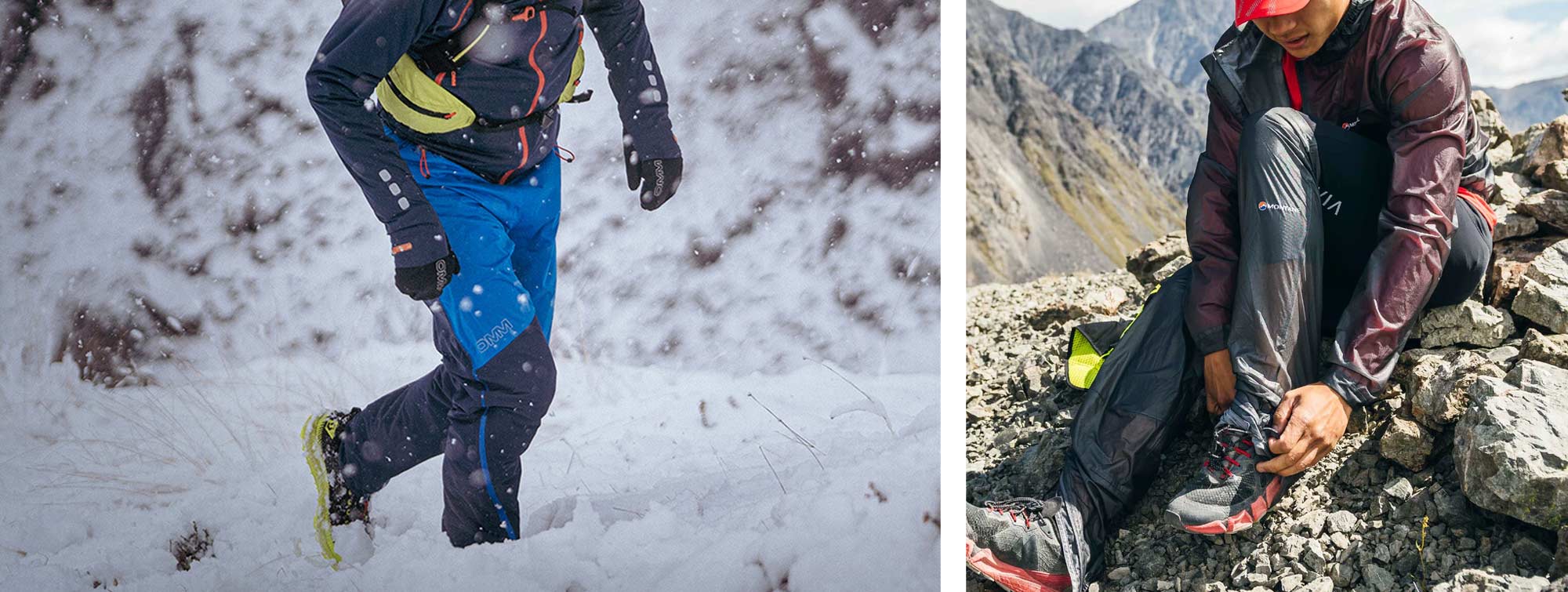
Overtrousers
You don’t want to get caught out when the rain really sets in in the middle of your run, and stands to reason that good pair of light weight running specific overtrousers are stowed away in your pack. Look out for highly breathable fabrics with figures greater than MVTR 10,000g or RET <6. Key features for runners are also important such as stretch fabrics, reflective details and full-length zips.
Top Picks; Podium Unisex Waterproof Pants and 2022 Kamleika Pants.
Poles
Running poles in the mountains helps aid propulsion and stabilise your posture. More popular for ultramarathons where the ability to keep our posture under fatigue wanes, however a great training tool to save overall impact and therefore injury prevention. Look out for poles that have a small compact stow system that will be easily popped in or attached to your running pack.
Top Picks; Carbon Skyrunner Running Poles, Trail Blaze Skyrunner Ultra Poles and 2022 Distance Carbon FLZ. Poles.


